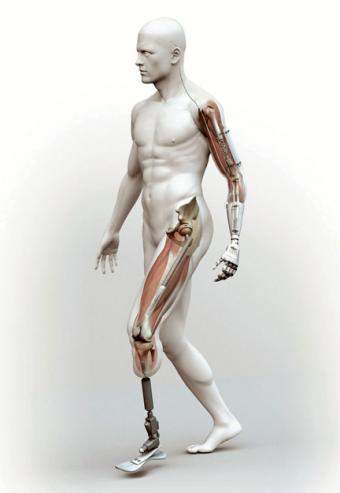PROVIDENCE, R.I. [Brown University] — The Center for Restorative and Regenerative Medicine, a multidisciplinary research effort to restore arm and leg function to amputees, has secured a new five-year, $7-million round of funding from the Department of Veterans Affairs (VA).
Roy Aaron, M.D., professor of orthopaedics at Brown’s Alpert Medical School and a VA investigator, created the center in 2004 and serves as its director. He said the funding renewal is a crucial win for the researchers and their work.
“The center’s renewal represents a significant vote of confidence from the Department of Veterans Affairs and the Department of Defense that our mission is valid and productive,” Aaron said. “Moreover, it allows us to continue our multidisciplinary, multi-institutional approach to problem solving.”
VA officials initially funded the center in 2004 with a $7.2-million, five-year award, launching the collaborative research initiative that includes the Providence VA Medical Center, Brown University and the Massachusetts Institute of Technology. Lifespan researchers are also involved.
There are 13 VA Rehabilitation Research Centers of Excellence nationwide, including the Center for Restorative and Regenerative Medicine. Each center comes up for review every five years, but not all of them are renewed, Aaron said.
The funding will help cover basic research as well as supplemental and salary costs. Researchers affiliated with the center are focused on improving the lives of individuals with limb trauma, particularly war veterans, through tissue restoration and advanced rehabilitation. They are also developing new prosthetics that lead to better mobility and greater control of limbs, and are more comfortable and less likely to cause infections compared with current prostheses.
Researchers focus on tissue engineering, orthopaedics, neurotechnology, prosthetics design, and rehabilitation — all in a bid to create “biohybrid” limbs made of both biological and man-made materials.
Among the projects under way in the center:
- a full physiological assessment of the Powered Ankle Foot prosthesis. In July 2007, the first powered ankle-foot prosthesis was unveiled, developed through the center by MIT Media Lab Professor Hugh Herr and his team of researchers;
- a study to demonstrate the effectiveness of robot-assisted rehabilitation for neurologic diseases and tissue engineering;
- studies on motion in the lower extremities, recently begun at the center’s new gait and motion laboratory. Further funding will allow for additional tests to demonstrate the feasibility of using the brain to control prosthetic devices such as the DEKA robotic arm.
Construction began in November 2008 on a new building at the Providence VA Medical Center campus that will house the center. The VA provided funding for the $6-million project, which will include nearly 24,000 square feet of basic science and clinical research space, dedicated to interdisciplinary rehabilitation research for veterans.

